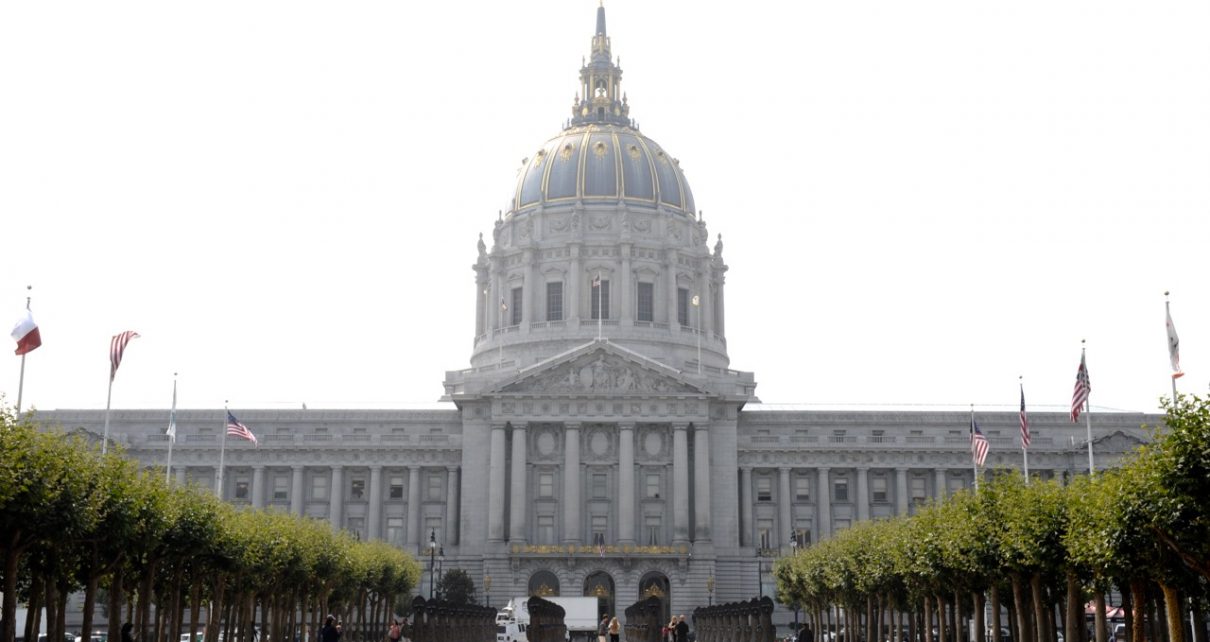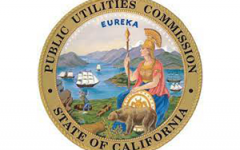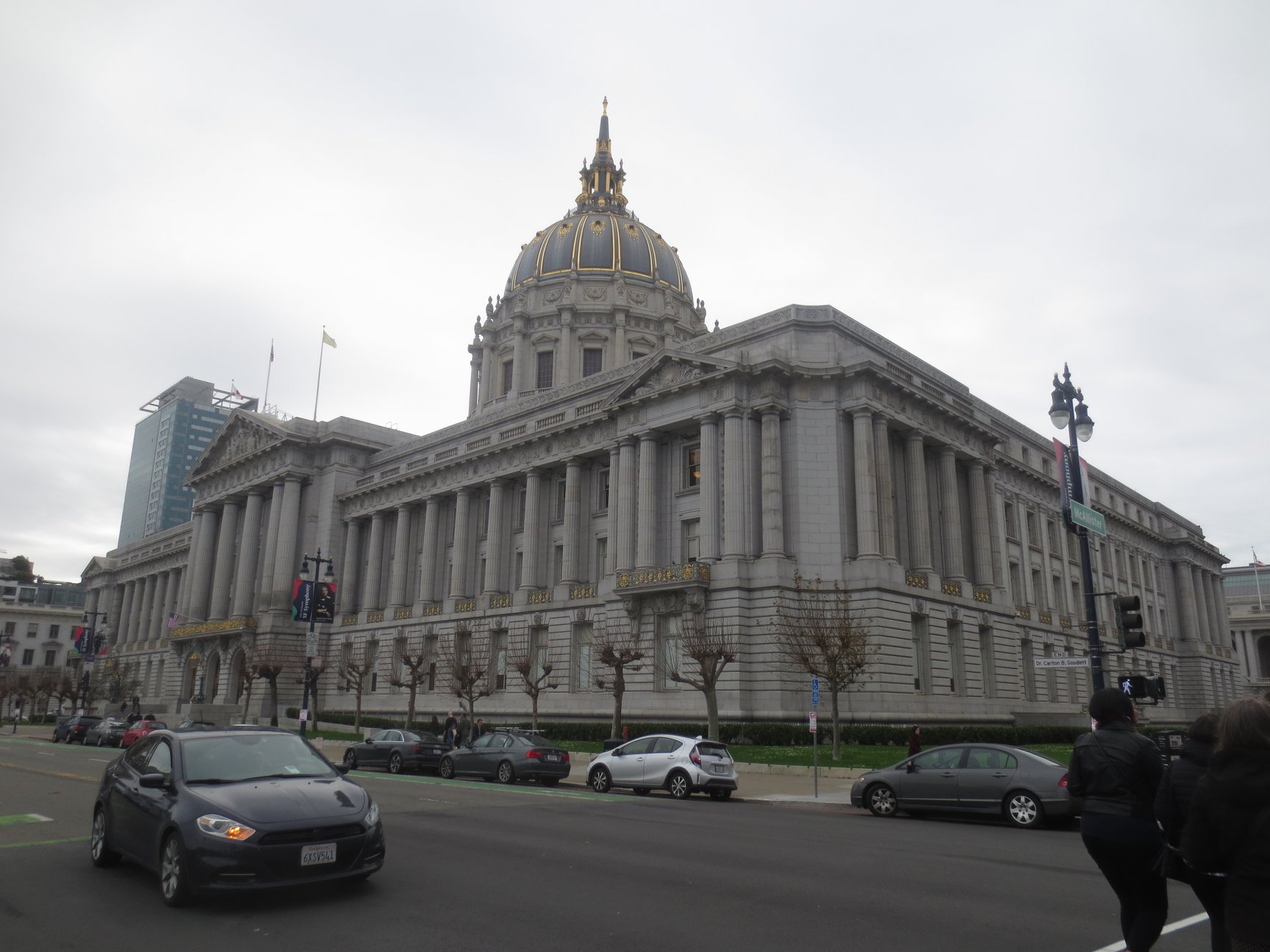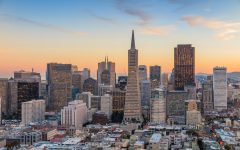
San Francisco City Hall (Photo: Kevin Sanders for California Globe)
City Of San Francisco Sues CPUC Over August 2023 Robotaxi Expansion Decision
‘Newsom saw all these accidents happen and people get hurt because of robotaxis but didn’t do anything’
By Evan Symon, January 26, 2024 12:31 pm
The City of San Francisco filed a lawsuit against the California Public Utilities Commission on Friday, asking them to review their decision made in August of last year to great expand robotaxi companies within the city.
In 2022 and most of 2023, Cruise enjoyed extensive growth in San Francisco and other cities in the U.S. alongside Google’s robotaxi service Waymo. In August 2023, Cruise had 300 vehicles driving around San Francisco at night and 100 during daytime hours, with Waymo only operating 250 vehicles during the day. While there were many complaints with the service, including reports of blocked traffic, blocked emergency workers, blocked mass transit, and other concerning issues, the CPUC voted 3-1 in August to expand robotaxi services in San Francisco by being able to offer paid rides at any time during the day throughout the city, and not be constrained by prior geographic limits, designated operating hours, and paid ride limits.
While Waymo generally had a safe record both before and after the vote, Cruise, which had a number of safety incidents be reported before August, had a huge number of incidents suddenly rack up with the expansion – 10 Cruise robotaxis stalled and caused a major backup. Another taxi careened into a construction site and got stuck in wet concrete. A Cruise vehicle even caused a passenger injury when it crashed into a firetruck. Faced with more and more of the public opposing robotaxis, and concerns growing over their safety, Cruise announced on August 22nd that their fleet of robotaxis would be cut in half.
Even with the reduced fleet, Cruise incidents still occurred at a high frequency. On October 2nd, a pedestrian who had just been struck by another car was struck by a Cruise vehicle despite otherwise stopped traffic, dragging the passenger for an additional 20 feet. Those accidents caused large-scale protests to break out statewide against driverless cars and robotaxi services.
Only days later on October 25th, the California DMV ordered Cruise to stop all operations in the state because of safety concerns over recent accidents. With San Francisco in doubt, and Los Angeles looking at ways to reign in robotaxis, Cruise announced on October 27th that they would be suspending operations nationwide because of safety concerns. In November, Cruise then announced massive layoffs because of the suspension of operations, GM putting less money into Cruise in 2024, as well as the resignation of Cruise CEO Kyle Vogt and co-founder Dan Kan. Despite this, CPUC continued to look into Cruise accidents, in particular the October 2nd pedestrian dragging incident.
In December, CPUC set up a court date to fine the company an additional $1.5 million over the October crash, as well as the firing of nine executives at the beleaguered company. However, with the company’s reputation now severely damaged and their ability to operate being effectively stymied by the government, Cruise announced later that month that over 900 employees, roughly 24% of their workforce, would be laid-off as a result. For San Francisco, things grew worse for them too when GM sued them for $121 million in back taxes and interest at the end of the year.
With San Francisco now soured on robotaxis and not wanting autonomous cars in the city until they are more strictly regulated, the city sued CPUC on Friday. In the suit, they said that the decision by CPUC was hasty, that it put people in danger, and that it passed against the objections of the city.
“As driverless autonomous vehicle services (AVS) expanded in San Francisco, members of the public and city officials identified hundreds of safety incidents, including interference with first responders,” said the lawsuit filed by City Attorney David Chiu. “Despite these serious safety incidents, and over the objections of San Francisco, the commission approved requests by Cruise and Waymo to operate.”
San Francisco Sues CPUC
While the suit doesn’t apply to Cruise, who stopped operating in the city last year, it would apply to Waymo. Should CPUC have to look into the ruling again and reverse it, Waymo, as well as any other robotaxi company looking to begin business in the city, would be limited once again in how they could operate.
In a statement on Friday, CPUC said that “it will respond to all claims through its pleadings and statements through the courts.” Questions of if they would reverse their August ruling or if they would place more regulations on driverless vehicles in the future remained unanswered.
Waymo issued a more detailed statement on Friday:
“Waymo is disappointed that the city has chosen to appeal the commission’s decision. However, we remain confident in our ability to continue safely serving San Francisco’s visitors and residents We have continually demonstrated our deep willingness and longtime commitment to work in partnership with California state regulators, San Francisco city officials and first responders and continue to stand by that approach.”
Experts told the Globe on Friday that the suit will likely pit safety concerns in San Francisco against a very pro-driverless car attitude of many lawmakers in Sacramento.
“You know who no one is talking about in this suit? Gavin Newsom,” said Charles Berg, a former auto industry advisor. “He’s not the main reason we are in this driverless car mess in California, but he is a big factor. While there were some officials in San Francisco praising these cars, due largely to companies setting up shop in the city and providing jobs, most were against it because they saw the safety issues firsthand. Mayor London Breed for example. She has routinely called them a threat, and when Cruise was suspended in October, she praised the DMV for their decision.”
“Now Newsom. He saw all these accidents happen and people get hurt because of robotaxis but didn’t do anything. He was wined and dined by Google and Larry Page and Sergey Brin and other companies years ago during driverless car development and pushed for their growth despite the number of accidents rising. He literally sided with the companies. So much so that he betrayed the unions last year when he vetoed AB 316, which would have required safety drivers in driverless trucks. You can bet he is going to have some words with CPUC now that their ruling from last year is now in danger. Waymo is Google owned, and those companies that impressed him years ago and really pushed him o driverless cars? Guess which one was the biggest? Google. I would bet if driverless cars were all over Sacramento like they had been in San Francisco, Newsom would have added regulations in a heartbeat.”
“This suit is still young, and there is a lot around it that can change. So, right now, it will do anything from nothing at all to greatly reducing driverless cars in San Francisco, namely Waymo.”
More on the suit is expected soon.
- Bill to Require Law Enforcement Disclosure if AI Was Used To Help Write Reports - August 7, 2025
- Gov. Newsom Files FOIA Request To ‘Expose True Cost’ Of L.A. Federal Troop Deployment for Anti-ICE Riots - August 6, 2025
- California Redistricting: How Newsom’s Plan Will Demolish Hard Fought GOP Gains - August 6, 2025





Commissioner John Reynolds was appointed to the CPUC by Democrat Governor Gavin Newsom on Dec. 23, 2021, and reappointed on Dec. 22, 2022. Prior to his appointment to the CPUC, Commissioner Reynolds had served as Managing Counsel at Cruise LLC since 2019. Do other CPUC commissioners have prior connections with robotaxi companies and/or have they received payoffs or other incentives from them?